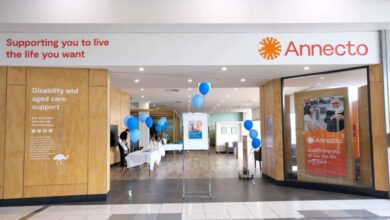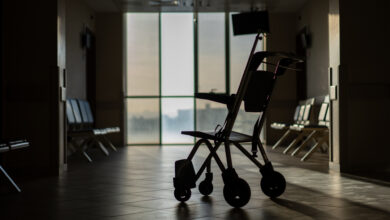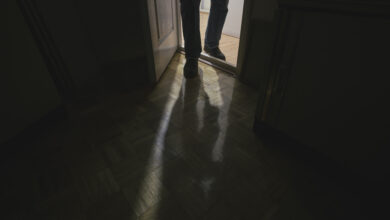Mobile dialysis gives patients a ticket home
A community-controlled Aboriginal health service is changing the experience of end-stage renal failure for many in outback Australia. By Linda Belardi.
Setting off from Uluru to Warburton on its maiden journey, a mobile dialysis truck is rolling into some of the most geographically remote communities in Australia. Emblazoned with artworks by celebrated Aboriginal artists, the “purple truck” is delivering community-based dialysis treatment to isolated patients with end-stage renal failure.
Settling in remote settlements for two months at a time, the mobile renal unit – in Warburton until April – will allow patients who are forced to travel thousands of kilometres to Alice Springs or Kalgoorlie to return home for treatment.
The mobile dialysis unit is the latest initiative of the Western Desert Dialysis Project – a small Aboriginal-controlled health service that has been fighting since 2003 to keep indigenous people in their remote communities while they receive treatment.
Health service manager Sarah Brown says the project – which has been shortlisted for a 2011 Australian Human Rights Commission award – is about keeping people connected to their community networks and cultural knowledge.
“Having fought really hard in the 1980s to return to country and to set up on their homelands, the prospect [for patients] of travelling to Alice Springs for life-long treatment away from family and friends carries with it a deep a sense of shame and dislocation,” says Brown. “They are on somebody else’s country – disconnected from their language, community and culture.”
Without local access to treatment many central Australians diagnosed with kidney disease frequently refuse or abandon treatment altogether. Individuals would also hide out in the bush delaying their move to Alice Springs. Others would arrive at the Alice Springs renal dialysis unit, become homesick and then hitch a ride back home refusing to comply with treatment. Without regular treatment some patients would become so critically ill they required emergency evacuation to intensive care, she says.
“Before there were machines in central Australia, dialysis was a one-way ticket to Alice Springs and then home for your funeral,” says Brown.
In 2003, the Western Desert Dialysis Project set about relocating treatment closer to home and established a permanent remote dialysis machine in Kintore in the Western Desert, located more than 500 kilometres west of Alice Springs. A second dialysis machine was also housed in Alice Springs to take some of the pressure off the major renal dialysis unit and to prepare patients to return to the bush. In 2004, the first patients were sent home for dialysis.
In Kintore, at any one time up to eight patients can be receiving dialysis treatment. The Western Desert Dialysis Project now provides support to some 80 people in Central Australia. But recent figures show there are more than 200 people in Central Australia on dialysis and this number is predicted to rise to 450-500 by 2020.
“What we can offer is something to look forward to,” says Brown. With the addition of the mobile dialysis truck, patients in more remote communities will be able to return home for weeks, not days.
“The truck means that we can give people a burst of being home. Some of these patients have never been home for more than one or two days while on dialysis.” Delivering a flexible service to meet the local needs of the community is also a priority. “We’re hoping to be reactive to the cultural priorities of our membership so that people can partake in important cultural events such as sorry business, the period before a funeral - or men’s business, to ensure that senior men are present in the community.”
Senior Pintupi members are prioritised by the service to remain in their community all the time and only return to Alice Springs for specialist appointments.
Brown and her team are also taking a dialysis machine to many remote communities that have never had access to a dialysis machine before. “An important part of the truck is to engage with people about the causes of kidney disease, to introduce early intervention screening and to try to demystify dialysis so it’s not seen as something as scary as people getting sick, disappearing to Alice Springs for treatment and not coming back.”
Early beginnings
Profits from artworks have been integral to the success of the project with an auction of large collaborative artworks by community members in Kintore and Kiwirrkurra in Western Australia seeding the project.
At an auction in 2000 at the Art Gallery of NSW, the indigenous communities raised more than $1 million, boosted by the sale of the Kiwirrkurra men’s painting to media mogul Kerry Stokes for $340,000. These funds helped purchase the first dialysis machines.
Ten years on and the model of community-based dialysis has expanded to include other remote communities in the Northern Territory – Yuendumu and Hermannsburg. The community in Yuendumu invested its gold-mining royalties to support the infrastructure and running costs of a service. The project team is also in the process of supporting Lajamanu, located west of Katherine and Warburton in WA to set up dialysis machines.
“We’re not trying to roll-out dialysis to 100 remote communities across Australia at the same time. It’s not some big dialysis intervention. We’re working on one or two communities at a time. Now we can also use our truck to access any community and try to build community support for establishing a more permanent service,” says Brown.
She says the communities are proud of what they have achieved.
“A huge part of this project is the fact that people had this idea, raised their own money and now they are responsible for getting family members home and spreading the model to other remote communities. People feel like they have some agency over their lives and they can make a difference,” she adds.
Despite a global shortage of dialysis nurses, the project has attracted a team of 10 nurses who have developed close ties with the local community.
“There are very few opportunities within Australia for dialysis nurses to work out bush, so we are attracting a certain type of adventurous dialysis nurse who really wants to live in the community, learn some of the local language and really get to know the local people,” says Brown.
“I was a remote area nurse for a long time, so I know the pressures on nurses living and working out bush. We try really hard to look after each other and to be quite flexible and family-friendly.”
Their geographic remoteness also means nurses are taking on extended roles in the absence of a doctor or nearby hospital.
Funding
For the first five years the service operated on self-generated funds but has since attracted funding support from a mixture of commonwealth and Northern Territory sources.
Brown stresses the importance of being community-controlled and the organisational freedom that comes from financial independence. There is, however, a delicate balance between government responsibility for indigenous health and self-governance and ownership, she says.
“Certainly funding is a challenge but it’s very important that the money is self-generated through art which means we can continue to provide services the way that people want them rather than following a government model.”
In August 2010, Federal Minister for Indigenous Health Warren Snowdon commissioned a $500,000 Central Australian renal study to improve services for indigenous patients on dialysis.
A final report was handed down in June last year but more than seven months’ later, Brown says, she is disappointed the report’s recommendations including more support for community dialysis have not been acted on.
The future
“Our hope is that people will have access to machines in at least most of the major remote communities. The mobile dialysis truck model can be used if you have hubs and spokes to fill in the gaps,” she says.
Teaching patients to self dialyse is a long-term goal for the project.
“We absolutely see on a daily basis the huge benefits of having people being at home. Comparing what life is like for them here [Alice Springs] and how they struggle being away from their community, there are real patient and economic benefits,” she says.
It is estimated that clinical costs of providing hospital treatment to someone on a dialysis machine is about $85,000 a year, but total government costs can reach $170,000 per dialysis patient per year to support them away from home.
“We can show people who are in their country, supported by their family are in hospital less, they dialyse better and live longer. They are out there working in their community arts centre, contributing to their community and bringing hundreds of thousands of dollars into the Territory economy.”
Brown is looking for a health economist to begin to cost the savings to government of community-based dialysis and the benefits to the local community.
Email: [email protected]





